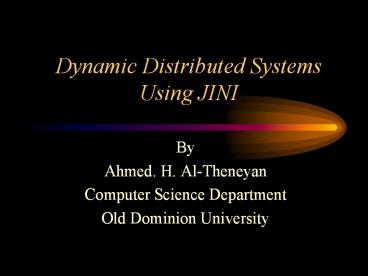Dynamic Distributed Systems Using JINI - PowerPoint PPT Presentation
1 / 30
Title:
Dynamic Distributed Systems Using JINI
Description:
... architecture brought out by SUN (TM). It enables the building ... JINI-USERS mailing list archives: http://archives.java.sun.com/archives/jini-users.html ... – PowerPoint PPT presentation
Number of Views:45
Avg rating:3.0/5.0
Title: Dynamic Distributed Systems Using JINI
1
Dynamic Distributed Systems Using JINI
- By
- Ahmed. H. Al-Theneyan
- Computer Science Department
- Old Dominion University
2
Outline
- What is JINI ?
- Goals and Objectives
- Architectural Overview
- Infrastructure
- Programming Model
- Services
- Conclusion
3
What is JINI (TM) ?
- Brand new distributed systems architecture
brought out by SUN (TM). - It enables the building of
- Dynamic
- Flexible
- Easily administered
- distributed system
- Simply, it enables Plug and Play networks
4
What does the word "JINI" stands for ?
- It is not an acronym, it does not stand for
anything. It is pronounced as 'Genie. As
in "JINI in a bottle." or "JINI of the lamp" in
Aladdin. That was one guess. - Bill Joy, one of JINIs project leaders, came up
with the name, because he liked the sound.
5
Goals and objectives
- Resources
- Management
- Sharing
- and access is more simple
- Distributed Programming is more easy
- Easy connection, no need for complicated setup
procedures - Simply, Dynamic Distributed Systems
6
Architectural Overview
- The whole technology can be segmented into
- Infrastructure
- Programming Model
- Services
7
Infrastructure
- Set of components, includes the minimal JINI
technology core, that enables building of the
system. - It includes
- Lookup Service
- Discovery/Join Protocol
- Distributed Security System
8
Lookup Service
- Central storage of services available within the
system - It is the fundamental part of the infrastructure.
- It organizes services into groups.
- Service can be a member of multiple groups.
- Multiple Lookup Services can maintain the same
group. - This helps to achieve fault tolerance.
9
How things work (Service Side)?
- When a new service is created, it register itself
with a Lookup Service (Join). - It must first locate the appropriate Lookup
service (Discovery). - This done using the Discovery/Join Protocol.
10
How things work (Client Side)?
- Client locate the appropriate Lookup Service
(Discovery). - It locates a service by querying the Lookup
Service (Lookup) - This done using the Discovery/Lookup Protocol.
- Then, Client and service can communicate
directly.
11
Discovery Protocol
- It can be
- Multicast Discovery Protocol.
- (looking for an appropriate Lookup Service)
- Unicast Discovery Protocol.
- (looking for a specific Lookup Service or
non-local Lookup service) - Multicast Announcement Protocol.
- (Allow Lookup services to advertise their
presence)
12
Multicast Request Protocol
13
Unicast Discovery Protocol
14
Multicast Announcement Protocol
15
Join Protocol
- A service discovers the appropriate Lookup
Service. - It connects via the Lookup Service registrar.
- The Service sends some info about itself.
- The Lookup Service stores the information and
associate it with the requested group, if any.
16
Join Protocol
17
Lookup Protocol
- A Client discovers the appropriate Lookup
Service. - Itll query for the service.
- If found, the object reference of the requested
service will be loaded into the client. - Finally, client invoke the service.
18
Lookup Protocol
19
Distributed Security System
- Define how entities got the right to perform
actions on their behalf or on behalf of others. - It extends JDK1.2 platforms security model to
the world of distributed systems.
20
Programming Model
- Set of interfaces that enables the construction
of reliable services. - These interfaces make up the distributed
extension of Java. - All interfaces are written in Java
- Free source code.
- Has no limit, and it can be extended.
21
Programming Model Cont..
- These interfaces include
- Leasing interface
- Events interface
- Transaction interface
22
Leasing interface
- Access to many services in the JINI system is
lease based. - Lease grant guaranteed access to the service over
a period of time. - It is negotiable.
- Can be exclusive or non-exclusive.
- Can be renewed.
23
Example
- When a service registers with the lookup service,
it receives a lease. - It need to renew periodically.
- When service failed or lease get expired, service
will be removed.
24
Distributed Events Interface
- It extends JavaBeans Event Model to the world of
Distributed Systems. - One object, Event Listener, registers an interest
in event of another object, Event Generator. - Listener will be notified in a timely and
reliable fashion. - Registration of interest is lease based
25
Transaction Interface
- Transactions enables operation grouping. Either
all Succeed or all Fail. - The JINIs Transaction Interface supply a service
protocol needed to coordinate 2-Phase commit
protocol.
26
Service
- Something that can be used by a person, program
or another service. - It can be Computational, Storage, Software,
Hardware or Communication Channel. - It has an interface which define the operations
that can be requested.
27
Services Cont..
- Service objects can be written in any language.
Client does not care. - But the interface has to be written in Java.
- One of them is JavaSpaces which can be used for
simple communication and storage of related
groups of objects.
28
Conclusion
- JINI is the feature of distributed systems
- The dynamic nature of JINI allows resources to be
added, subtracted at anytime without bothering
other components. - Open Source Code is available for download. Thus
it has no limit.
29
Questions
30
References
- The main JINI page at Sun http//java.sun.com/pro
ducts/jini/ - JINI specifications
http//java.sun.com/products/jini/specs/ - JINI-USERS mailing list archives
http//archives.java.sun.com/archives/jini-users.h
tml - Bill Venners' JINI/JavaSpaces talk
http//www.artima.com/javaseminars/modules/JINI/Ha
ndout.html - JINI Community Web Site, devoted to JINI
http//www.jinivision.com































